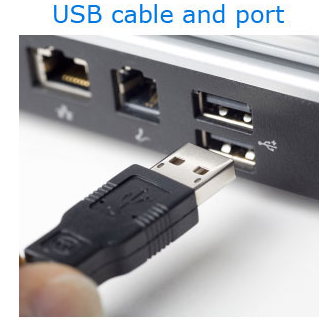Printer
A printer is an external hardware output device that takes the electronic data stored on a computer or other device and generates a hard copy of it. For example, if you created a report on your computer you could print several copies to hand out at a staff meeting. Printers are one of the most popular computer peripherals and are commonly used to print text and photos. The picture to the right is an example of an inkjet computer printer, the Lexmark Z605.
- Types of printers
- Printer interfaces
- History of various printers and how they work
- Related printer pages.
- Computer printer help and support.
Types of printers
Below is a list of all the different types of computer printers. Today, the most common printers used with a computer are Inkjet and Laser printers.
- 3D printer
- All-in-one (AIO) printer
- Dot matrix printer
- Inkjet printer
- Laser printer
- LED printer
- Multifunction printer (MFP)
- Plotter
- Thermal printer
Printer interfaces
There are a few different ways a printer can connect to and communicate with a computer (referred to as interfaces). Today, the most common connection types are by USB cable or via Wi-Fi. Below is a full list of cables and interfaces used to connect a computer to a printer.
- Cat5
- Firewire
- MPP-1150
- Parallel port
- SCSI
- Serial port
- USB
- Wi-Fi
History of various printers and how they work
Mechanical printer
The first mechanical printer was invented by Charles Babbage, for use with the Difference Engine, which Babbage developed in 1822. Babbage's printer utilized metal rods with printed characters on each rod to print text on rolls of paper that were fed through the device.
Dot matrix printer
The first dot matrix printer was created by IBM in 1957. However, the first dot matrix impact printer was introduced by Centronics in 1970. To create letters and images, the print head, which contains pins, sits over an ink ribbon. This ribbon rests just above a piece of paper. As the print head moves across the ribbon (usually horizontally), the pins are pressed into the ribbon to imprint ink onto the page (similar to a typewriter). As these pins print a series of dots, you can see where this printer got its name. See our dot matrix printer page for further information and related links.
Inkjet printer
While inkjet printers started being developed in the late 1950s, it wasn't until the late 1970s that they were able to reproduce decent digital images. These higher quality inkjet printers were developed by multiple companies, including Canon, Epson, and Hewlett-Packard. Inkjet printers are similar to dot matrix printers in that the images they create are composed of dots. However, the dots on an inkjet printer are shot onto the page rather than using a ribbon and pins. Furthermore, an inkjet printer's dots are much smaller, and their print speed is faster. See our inkjet printer page for further information about this printer.
Laser printer
In the early 1970s, Gary Starkweather invented the laser printer while working at Xerox by modifying one of their mode 7000 copiers. However, it wasn't until 1984 when Hewlett-Packard introduced the HP LaserJet that laser printers became more widely available and affordable. The following year, Apple introduced the Apple LaserWriter, which introduced PostScript technology to the printer market. Laser printers are a more complex than their predecessors. For information on how they work, check out our laser printer definition.
3D Printer
The 3D printer was created by Chuck Hull in 1984. 3D printers work by taking a digital blueprint of an object and reproducing it layer-by-layer using various materials such as plastic and metal alloys. See our 3D Printer definition for further information about this printer.
Related printer documents
How can I print a document or file?
General printer troubleshooting.
Listing of computer printer manufacturers.
Computer printer buying tips.
Computer printer help and support.
DPI, Hardware terms, Output device, Paper jam, Print, Print preview, Printing terms
















0 comments:
Post a Comment